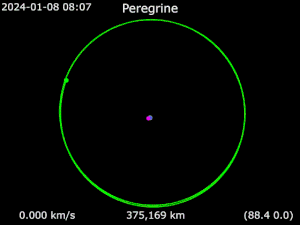Peregrine Mission One
 Peregrine ahead of launch | |
| Mission type | Lunar landing |
|---|---|
| Operator | Astrobotic Technology |
| COSPAR ID | 2024-006A |
| SATCAT no. | 58751 |
| Mission duration | 10 days (final) One lunar day (14 Earth days) on the Moon surface (planned) |
| Spacecraft properties | |
| Spacecraft | Peregrine |
| Launch mass | 1,283 kg (2,829 lb)[1] |
| Start of mission | |
| Launch date | 8 January 2024, 07:18:38 UTC |
| Rocket | Vulcan Centaur VC2S |
| Launch site | CCSFS, SLC-41 |
| End of mission | |
| Decay date | 18 January 2024, 21:04 UTC |
| Moon lander | |
| Landing date | 23 February 2024 (precluded) |
| Landing site | Sinus Viscositatis (Bay of Stickiness, precluded) |
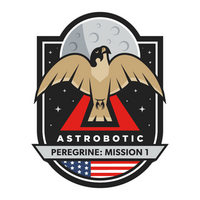 Mission Patch | |
Peregrine Lunar Lander flight 01, commonly referred to as Peregrine Mission One, was an unsuccessful American lunar lander mission. The lander, dubbed Peregrine, was built by Astrobotic Technology[2] and carried payloads for the NASA Commercial Lunar Payload Services (CLPS) program. Peregrine Mission One launched on 8 January 2024, at 2:18 am EST, on the maiden flight of the Vulcan Centaur (Vulcan) rocket. The goal was to land the first U.S.-built lunar lander on the Moon since the crewed Apollo Lunar Module on Apollo 17 in 1972.
The lander carried multiple payloads, with a payload capacity of 90 kg.[3] Shortly after the lander separated from the Vulcan rocket in lunar injection orbit, a propellant leak developed that prevented the lander from completing its mission. After six days in orbit, the spacecraft was redirected into Earth's atmosphere, where it burned up over the Pacific Ocean on 18 January 2024.[4]
History
[edit]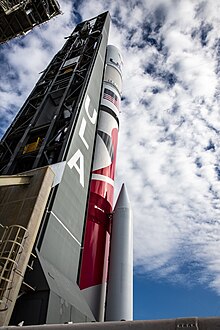
In July 2017, Astrobotic announced an agreement with United Launch Alliance (ULA) to launch their Peregrine lander aboard a Vulcan launch vehicle.[5] This first lunar lander mission, called Mission One, was initially to be launched in July 2021.[5][6]
On 29 November 2018, Astrobotic was made eligible to bid on NASAs Commercial Lunar Payload Services (CLPS) to deliver science and technology payloads to the Moon.[7]
In May 2019, Mission One received its first lander contract from NASA for 14 payloads.[8][9][10] It also had 14 commercial payloads, including small rovers from Hakuto, Team AngelicvM,[11] and a larger rover from Carnegie Mellon University, named Andy, which has a mass of 33 kg (73 lb) and is 103 cm (41 in) tall.[12] Another small rover, Spacebit, weighing 1.5 kg (3.3 lb), was designed to travel at least 10 m (33 ft) on four legs.[13][14][15][16] Other payloads include a library, in microprint on nickel, with Wikipedia contents and Long Now Foundation's Rosetta Project.[17][18] Space burial companies Elysium Space and Celestis paid Astrobotic to carry human remains.[19] The decision to include human remains was criticized by the Navajo Nation, whose president, Buu Nygren, argued that the Moon is sacred to the Navajo and other American Indian nations.[20][21]
In June 2021, ULA CEO Tory Bruno announced that payload and engine-testing problems would delay the maiden flight of Vulcan, with Mission One aboard, to 2022.[22] On 23 February 2023, ULA announced an expected launch date for the mission of 4 May 2023.[23] After an anomaly during testing of the Vulcan Centaur on 29 March, the launch was delayed until June or July,[24] and then until late 2023.[25]
In early December 2023, Bruno said problems found during a wet dress rehearsal of the rocket would likely delay the launch until the next launch window, on 8 January.[26]
Peregrine carries a maximum payload mass of 90 kg (200 lb) during Mission One,[27] and it was planned to land on Gruithuisen Gamma.[1]
The payload mass for the planned second mission (Mission Two) is capped at 175 kg (386 lb), and the Mission Three and later missions would carry the full payload capacity of 265 kg (584 lb).[1]
Lander
[edit]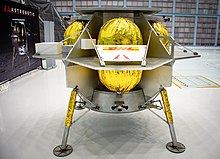
In 2016, Astrobotic announced plans to build the Peregrine lander,[28] based on their previous concept lander, Griffin, which was larger but with the same payload capacity.[28][29] Astrobotic hired Airbus Defence and Space to help refine the lander's design.
The Peregrine bus is largely of aluminum alloy, and it is reconfigurable for specific missions. Its propulsion system has five thrusters built by Frontier Aerospace,[30] each producing 150 lb (667 N) thrust. This propulsion system was designed to handle the trans-lunar injection, trajectory corrections, lunar orbit insertion, and powered descent. The propulsion system can deliver an orbiter to the Moon and perform a powered soft landing.[1] The lander can carry up to 450 kg (990 lb) of bi-propellant mass in four tanks; its composition is MON-25/MMH, a hypergolic bi-propellant.[31] For attitude control (orientation), the spacecraft uses 12 thrusters (45 N each) also powered by MON-25/MMH.[1]
The spacecraft's avionics incorporate guidance and navigation to the Moon, and a Doppler LiDAR to assist the automated landing on four legs.[28] From Mission 2, its landing ellipse will be 100 m x 100 m, down from 24 km × 6 km previously.[1]
Peregrine is about 2.5 m wide and 1.9 m tall, and would have been able to deliver up to 265 kg (584 lb) of payload to the surface of the Moon.[28][32][1][33]
Its electrical systems are powered by a lithium-ion battery that is recharged by a solar panel made of GaInP/GaAs/Ge. Radiators and thermal insulators are used to dispose of excess heat, but the lander does not carry heaters, so the first few Peregrine landers are not expected to survive the lunar night,[1] which lasts 14 Earth days. Future missions could be adapted to do so.[1]
For communications to Earth, the lander uses frequencies within the X-band range for uplink as well as downlink.[1] After landing, a 2.4 GHz Wi-Fi modem is to enable wireless communication between the lander and deployed rovers on the lunar surface.[1]
Payloads
[edit]Lunar rovers
[edit]| Country | Name | Agency or company | Summary |
|---|---|---|---|
| Colmena × 5 | Agencia Espacial Mexicana | Agencia Espacial Mexicana (AEM), the Mexican Space Agency, attempted to fly the first Latin American scientific instruments to the surface of the Moon. The payload consisted of five small robots, weighing less than 60 grams and measuring 12 centimeters in diameter, which were to be catapulted onto the lunar surface.[34] | |
| Iris | Carnegie Mellon University | Carnegie Mellon University's Iris was a 2 kg rover designed by university students. Its shoebox-sized chassis and bottle-cap wheels were made from carbon fiber, a first for planetary robotics. Iris was designed to test small, lightweight rover mobility on the Moon, collect images for geological sciences, and gather UWB RF ranging data for testing new relative localization techniques.[35] |
Instruments
| Country | Name | Agency or company | Summary |
|---|---|---|---|
| Laser Retroreflector Array (LRA) | NASA | A retroreflector is a device that bounces any light that shines on it directly backwards (180° from the incoming light) from it. The LRA was a collection of eight of these, each a 1.25-cm diameter glass corner cube prism, all embedded in an aluminum hemisphere (painted gold) and mounted to the lander deck. It was designed to efficiently retroreflect laser signals from other orbiting and landing spacecraft over a wide range of incoming directions, thereby enabling precise measurement of the distance between the orbiting or landing spacecraft to the lander. The LRA was to function as a location marker on the Moon for decades. (Note: this LRA design was too small for laser ranging from the Earth).[36] | |
| Linear Energy Transfer Spectrometer (LETS) | NASA | Space radiation can harm astronauts on exploration missions outside the Earth's protective atmosphere, and more so on the Moon than in Low Earth Orbit (LEO). The first source of risk is the total radiation dose from Galactic Cosmic Rays, which is about twice as high on the lunar surface as in LEO. The second source of risk is from space weather events resulting from solar activity. The Linear Energy Transfer Spectrometer (LETS) was a radiation monitor that was derived from heritage hardware flown on Orion EFT-1 and was slated to fly on the Orion EM-1 mission that would have enabled acquisition of knowledge of the lunar radiation environment and demonstrate the capabilities of the system on the lunar surface. This sensor was to measure the rate of incident radiation providing information that would be critical to understanding and mitigating the hazardous environment that people would experience as they explore the surface of the Moon.[36] | |
| M-42 Radiation Detector | DLR | This radiation detector was a complement to another scientific experiment riding aboard NASA's Artemis I mission. These sensors were to precisely measure the level of radiation a human body will encounter on a trip to the Moon and back. The data from both Artemis I and Peregrine Missions will improve our understanding of lunar spaceflight environmental conditions with respect to astronaut health, as space radiation will be one of the key risks in the future of Human Space Exploration.[37] | |
| Navigation Doppler Lidar (NDL) | NASA | NDL was a LIDAR-based (Light Detection and Ranging) descent and landing sensor. This instrument (LIDAR) operates on the same principles of radar but uses pulses of light from a laser instead of radio waves. NDL was to measure vehicle velocity (speed and direction) and altitude (distance to ground) with high precision during descent to touchdown.[38] | |
| Near-Infrared Volatile Spectrometer System (NIRVSS) | NASA | The payload included a spectrometer context imager and a longwave calibration sensor. It was to measure surface and subsurface hydration (H2O and OH) and CO2 and methane (CH4) while simultaneously mapping surface morphology and surface temperature. The plan was for the measurements to take place during rover traverse when integrated onto a rover, throughout areas of targeted volatile investigation (called science stations), and during drilling activities. This instrument was created at NASA Ames Research Center. In total, it had three specific instruments: the near-infrared spectrometer, Ames imaging module, and longwave calibration sensor.[36] | |
| Neutron Spectrometer System (NSS) | NASA | The NSS instrument was to determine the abundance of hydrogen-bearing materials and the bulk regolith composition at the landing site and measure any time variations in hydrogenous volatile abundance during the diurnal cycle. NSS could measure the total volume of hydrogen up to three feet below the surface, providing high-resolution ground truth data for measurements made from instruments in orbit around the Moon. NSS was to measure the number and energy of neutrons present in the lunar surface environment, which can be used to infer the amount of hydrogen present in the environment. This detection is possible because when neutrons strike a hydrogen atom, they lose a lot of energy.[36] | |
| Peregrine Ion-Trap Mass Spectrometer (PITMS) | NASA | PITMS was to characterize the lunar exosphere after descent and landing, and throughout the lunar day, to understand the release and movement of volatile species. Previous missions have demonstrated the presence of volatiles at the lunar surface, but significant questions remain about the where those volatiles came from and how they are transported across the lunar surface. Investigating how the lunar exosphere changes over the course of a lunar day can provide insight into the transport process for volatiles on the Moon. The instrument had the ability to measure the low level of gases expected in the lunar exosphere and released by regolith interaction with surface disturbances, like rovers.
The PITMS sensor had direct heritage from the Ptolemy mass spectrometer that made the first in situ measurements of volatiles and organics on comet 67P with the Rosetta lander, Philae. PITMS was to operate in a passive sampling mode, where molecules fall into the zenith-facing aperture and are trapped by a radiofrequency field, then sequentially released for analysis. PITMS had a unit mass resolution up to an upper mass-to-charge (m/z) limit of 150 Da. The PITMS investigation was to provide time-resolved variability of OH, H2O, noble gases, nitrogen, and sodium compounds released from the soil and present in the exosphere over the course of a lunar day. PITMS observations were to complement other instruments on board the Peregrine lander for a comprehensive approach to understanding the surface and exosphere composition, linking surface properties and composition to LADEE measurements from orbit, and providing a mid-latitude point of comparison for polar measurements planned by VIPER, PROSPECT, and other missions. The PITMS data was to provide a critical mid-latitude link to future polar mass specs to characterize the latitudinal migration of volatiles from equator to poles. PITMS was a joint NASA-ESA project implemented by NASA's Goddard Space Flight Center (GSFC) and ESA's contractors Open University (OU) and STFC RAL Space, with coordination and support provided by ESA's Space Research and Technology Centre (ESTEC). The integrated PITMS payload and science investigation were to be operated by GSFC with an international team of scientists.[36] | |
| Terrain Relative Navigation (TRN) | Astrobotic | Astrobotic was to demonstrate its standalone Terrain Relative Navigation (TRN) sensor as a payload on its first mission to the Moon. TRN was to enable spacecraft to perform landings on planetary surfaces with an unparalleled accuracy of less than 100 meters. The TRN sensor was being developed under a $10 million NASA Tipping Point contract with NASA Johnson Space Center, Jet Propulsion Laboratory, and Moog.[37] |
Time capsules
[edit]| Country | Name | Agency or company | Type |
|---|---|---|---|
| Bitcoin Magazine Genesis Plate | BIT Inc. | Plaque | |
| DHL MoonBox | DHL | Commercial payload capsules | |
| Lunar Codex[39] | Incandence | Artwork, books, stories, music | |
| Footsteps on the Moon | Lunar Mission One | Image bank | |
| Luna 02 | Celestis | Memorial capsule | |
| Lunar Bitcoin | BitMEX | Cryptocurrency | |
| Lunar Dream Capsule[40] | Astroscale | Time capsule | |
| Memorial Space Flight Services | Elysium Space | Memorial capsule | |
| Memory of Mankind on the Moon | Puli Space Technologies | Time capsule | |
| MoonArk | Carnegie Mellon University | Lunar Museum | |
| The Arch Libraries | Arch Mission Foundation | Time capsule | |
| Writers on the Moon | Writers on the Moon | Stories by 133 authors |
Mission
[edit]Launch and trajectory
[edit]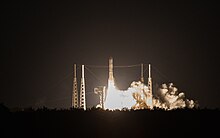
On 8 January 2024 ULA used the inaugural flight of the Vulcan Centaur rocket to launch the Peregrine mission. Lift-off from Cape Canaveral Space Launch Complex 41 took place at 2:18 am EST.[41] The rocket was launched in the VC2S configuration, with two solid rocket boosters and a standard-length fairing. The solid rocket boosters separated from the vehicle at T+1 minute 50 seconds. The first stage continued firing its BE-4 engines until T+4:59 and separated a few seconds later. The Centaur upper stage started its first burn at T+5:15, which took more than 10 minutes to complete and put the vehicle into a low Earth orbit. Following a coast phase, the Centaur fired for the second time at T+43:35 to start the trans-lunar injection burn, which lasted about three minutes. The Peregrine lander separated from the rocket at T+50:26.[42]
Peregrine was to take a 46-day trajectory to the Moon, performing burns to enter lunar orbit and slowly approach the lunar surface. Landing was planned for 23 February 2024.[42]
Propellant leak
[edit]Roughly seven hours after the launch, Astrobotic reported that a problem, likely with the propulsion system, had "prevented [the lander] from achieving a stable sun-pointing orientation".[43] The company conducted an unplanned maneuver of the spacecraft to turn the solar panels toward the Sun,[44] and, after an expected communications blackout, confirmed that the spacecraft was once again generating sufficient power. However, the problem was identified as a gradual propellant leak that required constant consumption of fuel to counteract. At 21:16 EST, Astrobotic said in a statement that thrusters were operating "well beyond their expected service life cycles" and that the "spacecraft could continue in a stable sun-pointing state for approximately 40 more hours" before it would run out of fuel, then lose attitude control and power.[45]
Later, the company confirmed that Peregrine could no longer land on the Moon, although it could continue to operate as a spacecraft.[46] Photographs taken by the spacecraft showed damage to external insulation,[47][48] perhaps caused by a valve that failed to fully close, causing the oxidizer tank to rupture.[49][50]
Four days into the mission, the propellant leak appeared to slow, and Astrobotic reported that "there is growing optimism that Peregrine could survive much longer" than was previously anticipated.[45]
Reentry
[edit]The spacecraft eventually reached a position that would have allowed it to reach the Moon with trajectory corrections.[51] Six days into the mission, Astrobotic decided to direct the spacecraft to burn up in Earth's atmosphere to avoid space debris.[52] In the end, the spacecraft never left the (highly elliptical) Earth orbit that the carrier rocket injected it into (except to make a controlled re-entry into Earth's atmosphere).
A controlled re-entry took place at 15:59 on 18 January EST (20:59 UTC),[53] with possible impact somewhere near Point Nemo, a spacecraft cemetery in the South Pacific. The last contact with the spacecraft was achieved by DSS36, an antenna of the DSN in Canberra.[54]
Future
[edit]Peregrine was the first of NASA's CLPS missions, with the second, Intuitive Machines' Odysseus, which launched and landed on the moon in February 2024.[55] Astrobotic will have a second landing attempt, consisting of the larger Griffin lander, with launch previously scheduled for November 2024.[56]
References
[edit]- ^ a b c d e f g h i j k "Astrobotic: Payload User Guide". Astrobotic Technology. 2018. Archived from the original on 3 June 2019. Retrieved 10 December 2018.
- ^ Kenneth Chang (7 January 2024). "Vulcan Rocket's Inaugural Launch Carries Moon Lander to Space – Here's what you need to know about United Launch Alliance and the robotic lunar spacecraft it is sending to orbit". The New York Times. Archived from the original on 7 January 2024. Retrieved 8 January 2024.
- ^ "Peregrine Mission 1 (Astrobotic)". nssdc.gsfc.nasa.gov. Archived from the original on 4 December 2023. Retrieved 31 October 2023.
- ^ Jackie Wattles (19 January 2024). "Astrobotic's Peregrine lunar lander burns up over Pacific Ocean". CNN. Archived from the original on 19 January 2024. Retrieved 19 January 2024.
- ^ a b Mike Wall (3 October 2019). "SpaceX Falcon 9 Rocket Will Launch Private Moon Lander in 2021". Space.com. Archived from the original on 4 October 2019. Retrieved 2 October 2019.
- ^ "Astrobotic Awarded US$79.5 Million Contract to Deliver 14 NASA Payloads to the Moon". www.astrobotic.com (Press release). Astrobotic Technology. 31 May 2019. Archived from the original on 4 September 2020. Retrieved 20 August 2019.
- ^ "NASA Announces New Partnerships for Commercial Lunar Payload Delivery Services". nasa.gov (Press release). NASA. 29 November 2018. Archived from the original on 25 November 2020. Retrieved 29 November 2018.
 This article incorporates text from this source, which is in the public domain.
This article incorporates text from this source, which is in the public domain.
- ^ "NASA funds commercial Moon landers for science, exploration". Astronomy Now. 2 June 2018. Archived from the original on 8 June 2019. Retrieved 20 August 2019.
- ^ Mike Wall (1 June 2018). "These Are the Private Lunar Landers Taking NASA Science to the Moon". Space.com. Archived from the original on 9 August 2019. Retrieved 20 August 2019.
- ^ Loren Grush (5 June 2019). "This tiny rover will test how well small mobile robots can survive on the Moon". The Verge. Archived from the original on 13 August 2023. Retrieved 20 August 2019.
- ^ Michael Cole (19 March 2018). "Astrobotic Ready to Become Delivery Service to the Moon". Spaceflight Insider. Archived from the original on 21 October 2019. Retrieved 20 August 2019.
- ^ "Andy's Mission". Planetary Robotics Lab. Carnegie Mellon University. Archived from the original on 3 February 2015. Retrieved 20 December 2018.
- ^ Ryan Browne (10 October 2019). "Britain's first Moon rover is a four-legged robot that will explore lunar tunnels". CNBC. Archived from the original on 12 October 2019. Retrieved 10 October 2019.
- ^ "SpaceBit Moon rover set to land on lunar surface in 2021". Sky News. 10 October 2019. Archived from the original on 10 January 2024. Retrieved 10 January 2024.
- ^ Stuart McDill (10 October 2019). "Tiny walking rover bound for the moon". Reuters. Archived from the original on 10 October 2019. Retrieved 10 October 2019.
- ^ Mike Wall (12 October 2019). "UK's 1st Moon Rover to Launch in 2021". Space.com. Archived from the original on 13 October 2019. Retrieved 14 October 2019.
- ^ Mike Wall (16 May 2018). "'Lunar Library' Aims to Preserve Humanity's History On the Moon (Wikipedia, Too)". Space.com. Archived from the original on 11 May 2019. Retrieved 16 May 2018.
- ^ Loren Grush (15 May 2018). "This nonprofit plans to send millions of Wikipedia pages to the Moon — printed on tiny metal sheets". The Verge. Archived from the original on 30 May 2019. Retrieved 16 May 2018.
- ^ Jackie Wattles (8 January 2024). "First US Moon landing mission in decades launches with NASA science, humans remains on board". CNN. Archived from the original on 11 January 2024. Retrieved 8 January 2024.
- ^ Jackie Wattles (7 January 2024). "First US Moon mission in decades to launch with NASA science, human remains on board". CNN. Archived from the original on 7 January 2024. Retrieved 8 January 2024.
- ^ Stephen Clark (7 January 2024). "Navajo objection to flying human ashes to the Moon won't delay launch". Ars Technica. Archived from the original on 7 January 2024. Retrieved 8 January 2024.
- ^ Eric Berger (25 June 2021). "Rocket Report: China to copy SpaceX's Super Heavy? Vulcan slips to 2022". Ars Technica. Archived from the original on 29 June 2021. Retrieved 30 June 2021.
- ^ Loren Grush (23 February 2023). "United Launch Alliance Delays Vulcan Debut Flight to Early May". Bloomberg. Archived from the original on 27 February 2023. Retrieved 22 March 2023.
- ^ Nate Doughty (19 April 2023). "ULA rocket taking Astrobotic's lunar lander to space pushes back departure date following explosion during testing". www.bizjournals.com. Archived from the original on 19 April 2023. Retrieved 25 April 2023.
- ^ Eric Berger (14 June 2023). "Vulcan aces engine test, but upper stage anomaly will delay launch for a while "Working corrective action and retest."". Ars Technica. Archived from the original on 14 June 2023. Retrieved 14 June 2023.
- ^ Tory Bruno [@torybruno] (10 December 2023). "#VulcanRocket WDR update: Vehicle performed well. Ground system had a couple of (routine) issues, (being corrected). Ran the timeline long so we didn't quite finish. I'd like a FULL WDR before our first flight, so XMAS eve is likely out. Next Peregrine window is 8 Jan" (Tweet) – via Twitter.
- ^ "Peregrine Lander". www.astrobotic.com. Astrobotic Technology. Archived from the original on 23 February 2017. Retrieved 5 June 2019.
- ^ a b c d Jeff Foust (3 June 2016). "Astrobotic unveils Peregrine lunar lander". SpaceNews.com. Archived from the original on 17 October 2022. Retrieved 20 August 2019.
- ^ "Griffin Lander". www.astrobotic.com. Astrobotic Technology. Archived from the original on 11 December 2018. Retrieved 10 December 2018.
- ^ "Frontier Aerospace Selected for NASA Award to Develop Deep Space Thruster Using MON-25/MMH Propellant". www.astrobotic.com. Astrobotic Technology. Archived from the original on 1 October 2019. Retrieved 1 October 2019.
- ^ "Aerojet Rocketdyne Successfully Demonstrates Low-Cost, High Thrust Space Engine". Aerojet Rocketdyne (Press release). 23 May 2018. Archived from the original on 20 August 2019. Retrieved 20 August 2019.
- ^ Jeff Foust (13 June 2016). "Landers, laws, and lunar logistics". The Space Review. Archived from the original on 14 August 2019. Retrieved 20 August 2019.
- ^ Debra Werner (24 October 2019). "Spacebit forms partnership, prepares to send tiny rover to the Moon". SpaceNews.com. Archived from the original on 17 October 2022. Retrieved 28 January 2020.
- ^ "Moon Manifest". www.astrobotic.com. Astrobotic Technology. Archived from the original on 4 January 2024. Retrieved 3 January 2024.
- ^ "IRIS Home". Archived from the original on 6 January 2024. Retrieved 3 January 2024.
- ^ a b c d e "Task Order TO2-AB Scientific Payloads – NASA Science". nasa.gov. NASA. Archived from the original on 7 December 2023. Retrieved 5 December 2023.
- ^ a b "Astrobotic — Launch Info Packet 5.8-1" (PDF). www.astrobotic.com. Astrobotic Technology. Archived (PDF) from the original on 30 November 2023. Retrieved 5 December 2023.
- ^ "Astrobotic-Press Kit 508" (PDF). nasa.gov. NASA. Archived (PDF) from the original on 29 November 2023. Retrieved 5 December 2023.
- ^ J. D. Biersdorfer (7 July 2023). "A Time Capsule of Human Creativity, Stored in the Sky". The New York Times. Archived from the original on 27 July 2023. Retrieved 7 July 2023.
- ^ "Otsuka's POCARI SWEAT Aims the Very First Moon Landing". Business Wire. 15 May 2014. Archived from the original on 17 October 2022. Retrieved 6 February 2021.
- ^ Jeff Foust (8 January 2024). "Vulcan Centaur launches Peregrine lunar lander on inaugural mission". SpaceNews.com. Archived from the original on 8 January 2024. Retrieved 8 January 2024.
- ^ a b Aaron McCrea (8 January 2024). "Vulcan successfully launches Peregrine lunar lander on inaugural flight". NASASpaceflight.com. Archived from the original on 8 January 2024. Retrieved 8 January 2024.
- ^ Eric Berger (8 January 2024). "Hours after its launch, a US lunar lander experiences an anomaly". Ars Technica. Archived from the original on 8 January 2024. Retrieved 8 January 2024.
- ^ Brett Tingley (8 January 2024). "Private Peregrine Moon lander suffers anomaly after historic Vulcan rocket launch, Astrobotic says". Space.com. Archived from the original on 8 January 2024. Retrieved 8 January 2024.
- ^ a b Astrobotic [@astrobotic] (12 January 2024). "Update #13 for Peregrine Mission One: Peregrine has now been operational in space for more than 4 days" (Tweet) – via Twitter.
- ^ Astrobotic [@astrobotic] (9 January 2024). "Update #7 for Peregrine Mission One: The Peregrine spacecraft has now been operational for about 32 hours" (Tweet) – via Twitter.
- ^ Mike Wall (8 January 2024). "1st photo from crippled private Peregrine moon lander holds clue to anomaly". Space.com. Archived from the original on 10 January 2024. Retrieved 10 January 2024.
- ^ Oliver Holmes (9 January 2024). "Peregrine 1 has 'no chance' of landing on moon due to fuel leak". The Guardian. Archived from the original on 10 January 2024. Retrieved 10 January 2024.
- ^ Mike Wall (9 January 2024). "Stuck valve may have doomed private Peregrine moon lander mission, Astrobotic says". Space.com. Archived from the original on 10 January 2024. Retrieved 10 January 2024.
- ^ Astrobotic [@astrobotic] (9 January 2024). "Update #8 for Peregrine Mission One: Astrobotic's current hypothesis about the Peregrine spacecraft's propulsion anomaly is that a valve between the helium pressurant and the oxidizer failed to reseal after actuation during initialization" (Tweet) – via Twitter.
- ^ Astrobotic [@astrobotic] (12 January 2024). "Update #15 for Peregrine Mission One: Peregrine remains operational at 238,000 miles from Earth, which means that we have reached lunar distance!" (Tweet) – via Twitter.
- ^ Astrobotic Technology (14 January 2024). "Update #17 for Peregrine Mission One". www.astrobotic.com. Archived from the original on 15 January 2024. Retrieved 15 January 2024.
- ^ Richard Stephenson [@nascom1] (18 January 2024). "As predicted by the APM1 team, Peregrine had loss of signal at 20:59 over Canberra's DSS36. It was a shame it had to end this way, but the mission did it in style. This is the doppler profile from its final approach. It was a graceful dive" (Tweet) – via Twitter.
- ^ Jonathan Amos (18 January 2024). "Peregrine lander: American Moon mission destroyed over Pacific Ocean". BBC News. Archived from the original on 18 January 2024. Retrieved 18 January 2024.
- ^ Jeff Foust (19 December 2023). "Intuitive Machines delays first lunar lander launch to February". SpaceNews.com. Archived from the original on 11 January 2024. Retrieved 20 December 2023.
- ^ Tricia Talbert (18 July 2022). "NASA Replans CLPS Delivery of VIPER to 2024 to Reduce Risk". nasa.gov. NASA. Archived from the original on 18 July 2022. Retrieved 18 July 2022.

